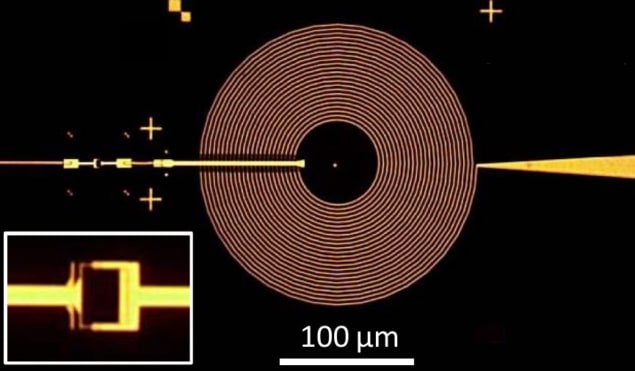 University of Paris-Saclay and colleagues built their device by connecting a Josephson junction with a microwave resonator. While the team did not establish that the photons are entangled, previous research suggests that the device could be a source of multiple entangled photons.
University of Paris-Saclay and colleagues built their device by connecting a Josephson junction with a microwave resonator. While the team did not establish that the photons are entangled, previous research suggests that the device could be a source of multiple entangled photons.
The ability to produce pairs of entangled photons is vital for many quantum technologies. Most often, it involves a technique called parametric down-conversion, whereby a single photon is split into two lower-energy photons after interacting with a nonlinear optical medium. This technique could be used to produce higher numbers of entangled photons, but such a system would be bulky and complex.
Ménard, Peugeot and colleagues have now shown that multiple photons can be produced far more easily using a simple superconducting circuit that comprises a capacitor, a coil inductor, and a Josephson junction. The circuit was etched onto a 150 nm-thick niobium film that had been deposited onto a quartz substrate. Niobium is a superconductor at low temperatures.
Simple quantum device
A Josephson junction is a simple quantum device in which two superconductors are separated by a thin insulating barrier. When a voltage is applied across the junction, Cooper pairs of electrons – the charge carriers responsible for superconductivity – can tunnel through the barrier. In the process, they acquire an amount of energy that is proportional to the applied voltage, exciting them to a higher energy level.
The capacitor and inductor coil are tuned so that the circuit resonates at the frequency of a microwave photon. When a Cooper pair flows through the circuit, its excess energy is converted into one or more microwave photons – each having the same frequency as the circuit. The number of emitted photons depends on the energy of the Cooper pair, and therefore on the voltage across the Josephson junction. Increasing the voltage increases the number of emitted photons, and by doing this the team was able to create up to six photons at a time.
In a previous experiment, the team showed that pairs of photons produced in this way are entangled – and therefore could be useful in quantum technologies. If it turns out that the multiple photons are also entangled, the technique could someday be used in a wide range of applications including secure quantum communications and quantum computing.
The research is described in Physical Review X.
